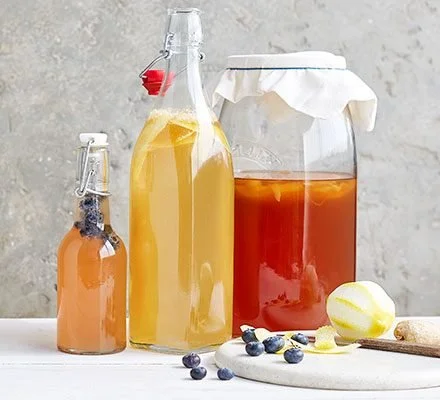Probiotics
In this blog I want to look at probiotics focussing on natural probiotics and a few of the foods you can buy or make yourself. I have taken recipes from BBCgoodfood.
What is a probiotic?
A probiotic is best described as a microorganism which naturally occurs in cultured foods and which improves the health of its host (you!). Probiotic foods naturally contain probiotic cultures of yeast or bacteria. Probiotic bacteria perform some important functions such as supporting a healthy immune system, metabolism and digestion.
Your gut microbiome is strongly influenced by your food choices and you can easily support this by including more probiotic rich foods into your daily diet.
Can you tell us a bit about probiotics and what probiotics are good to try?
Probiotics work for some people, not everyone. Unfortunately we don’t have a lot of good research for IBS however it is worth trying natural occurring probiotics like kefir, natural yoghurt, sauerkraut, kimchi, you can buy these things in the supermarket. If you try these and they’re not working you can try probiotic capsules; I would suggest an 8 week course of probiotics with lactobacilli and bifidobacterium such as Bio-Kult or PrescriptBiotics. There is some concern that we use capsules we’re going to develop resistance to some of those bacteria, so just keep that in mind. If they’re not working after 6-8 weeks I would just stop them completely.
Can you give us some tips on what natural probiotics to eat?
Kefir
The name kefir comes from the Turkish word “keyif,” which refers to “good feeling". The drink is a combination of milk and kefir grains and contains live bacteria and yeast. Made by adding kefir grains to cow’s or goat’s milk, kefir contains several major strains of friendly bacteria and yeast, making it a diverse and potent probiotic.
Some people attribute kefir’s potential health benefits to its probiotic content. Probiotics are beneficial species of bacteria and other microbes. Research on probiotics is still in its early stages.
Kefir has a tart and tangy flavor and a consistency similar to drinkable yogurt. Due to the fermentation process, kefir may taste slightly carbonated. This happens because the microbes produce gases as they digest the sugars in the milk.
Types
There are many types of kefir. People can purchase or make it using:
cow’s, sheep’s, or goat’s milk
nondairy milk, such as coconut or oat milk
juice
water
What’s the best way to make kefir?
For a stronger flavour, use an open system: cover a 500ml jar with a cloth cap or kitchen towel and rubber band, ensuring there are several inches of air above the milk. The closed system uses a 500ml clip-top jar with a rubber gasket to keep oxygen out. The microbes in the kefir grains are able to grow well with just a little oxygen present. These conditions will also ensure that Lactobacilli grows better than other types of microbes, reducing yeasty flavours and fizz (though the amount of grains used is also very important – the more grains you use, the faster the fermentation and stronger the flavour. Use 5-10g grains per litre of milk for a milder flavour).
Where can I buy kefir grains?
If you know someone who already makes kefir, ask them if you can have some. As little as half a teaspoon will be enough to make your own. Alternatively, fresh grains can be purchased online. If they arrive in the post, they may need a little reinvigorating after their journey – put them in a small jar and cover with whole milk (you won’t need more than 100ml). Cover and leave at room temperature for 12-48 hours until the milk has set (it varies depending on the milk used and its temperature). When it does, you’re good to go and can scale up.
Kimchi
A Korean favourite, kimchi is made primarily with fermented cabbage and contains large amounts of the gut-friendly bacterium, Lactobacillus.
Ingredients
1 Chinese cabbage
3 garlic cloves, crushed
2.5cm/1in piece ginger, grated
2 tbsp fish sauce (optional)
2 tbsp sriracha chilli sauce or chilli paste (see below)
1 tbsp golden caster sugar
3 tbsp rice vinegar
8 radishes, coarsely grated
2 carrots, cut into matchsticks or coarsely grated
4 spring onions, finely shredded
Method
STEP 1
Slice the cabbage into 2.5cm strips. Tip into a bowl, mix with 1 tbsp sea salt, then set aside for 1 hr. Meanwhile, make the kimchi paste by blending the garlic, ginger, fish sauce (if using), chilli sauce, sugar and rice vinegar together in a small bowl.
STEP 2
Rinse the cabbage under cold running water, drain and dry thoroughly. Transfer to a large bowl and toss through the paste, along with the radishes, carrot and spring onions. Serve straight away or pack into a large jar, seal and leave to ferment at room temperature overnight, then chill. Will keep in the fridge for up to 2 weeks - the flavour will improve the longer it's left.
Kombucha
A sweetened fermented black tea from China, kombucha is known to contain a host of gut-beneficial bacteria and yeast species.
Why not try making your own kombucha? If making it yourself is a bit daunting then it's also available to buy in Sainsburys or Holland and Barrett.
https://www.bbcgoodfood.com/recipes/kombucha-recipe




